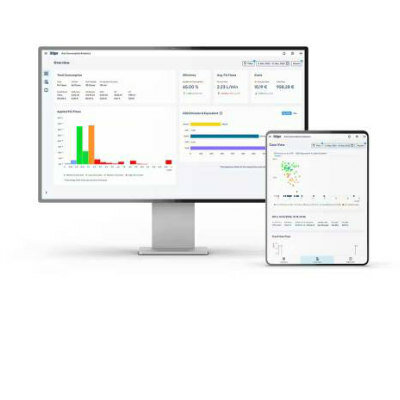AI Tool Accurately Predicts Risk of Death in Patients with Suspected or Known Heart Disease
|
By HospiMedica International staff writers Posted on 13 Dec 2021 |

A novel artificial intelligence (AI) score provides a more accurate forecast of the likelihood of patients with suspected or known coronary artery disease dying within 10 years than established scores used by health professionals worldwide.
The study by researchers at the Johns Hopkins Hospital (Baltimore, MD, USA) showed that unlike traditional methods based on clinical data, the new score also includes imaging information on the heart, measured by stress cardiovascular magnetic resonance (CMR). "Stress" refers to the fact that patients are given a drug to mimic the effect of exercise on the heart while in the magnetic resonance imaging scanner.
Risk stratification is commonly used in patients with, or at high risk of, cardiovascular disease to tailor management aimed at preventing heart attack, stroke and sudden cardiac death. Conventional calculators use a limited amount of clinical information such as age, sex, smoking status, blood pressure and cholesterol. This study examined the accuracy of machine learning using stress CMR and clinical data to predict 10-year all-cause mortality in patients with suspected or known coronary artery disease, and compared its performance to existing scores.
The study included 31,752 patients referred for stress CMR because of chest pain, shortness of breath on exertion, or high risk of cardiovascular disease but no symptoms. High risk was defined as having at least two risk factors such as hypertension, diabetes, dyslipidaemia, and current smoking. The average age was 64 years and 66% were men. Information was collected on 23 clinical and 11 CMR parameters. Patients were followed up for a median of six years for all-cause death, which was obtained from the national death registry in France. During the follow up period, 2,679 (8.4%) patients died.
Machine learning was conducted in two steps. First it was used to select which of the clinical and CMR parameters could predict death and which could not. Second, machine learning was used to build an algorithm based on the important parameters identified in step one, allocating different emphasis to each to create the best prediction. Patients were then given a score of 0 (low risk) to 10 (high risk) for the likelihood of death within 10 years. The machine learning score was able to predict which patients would be alive or dead with 76% accuracy (in statistical terms, the area under the curve was 0.76).
Using the same data, the researchers calculated the 10-year risk of all-cause death using established scores (Systematic COronary Risk Evaluation [SCORE], QRISK3 and Framingham Risk Score [FRS]) and a previously derived score incorporating clinical and CMR data (clinical-stress CMR [C-CMR-10])2 – none of which used machine learning. The machine learning score had a significantly higher area under the curve for the prediction of 10-year all-cause mortality compared with the other scores: SCORE = 0.66, QRISK3 = 0.64, FRS = 0.63, and C-CMR-10 = 0.68.
“This is the first study to show that machine learning with clinical parameters plus stress CMR can very accurately predict the risk of death,” said study author Dr. Theo Pezel of the Johns Hopkins Hospital. “The findings indicate that patients with chest pain, dyspnoea, or risk factors for cardiovascular disease should undergo a stress CMR exam and have their score calculated. This would enable us to provide more intense follow-up and advice on exercise, diet, and so on to those in greatest need.”
“Stress CMR is a safe technique that does not use radiation. Our findings suggest that combining this imaging information with clinical data in an algorithm produced by artificial intelligence might be a useful tool to help prevent cardiovascular disease and sudden cardiac death in patients with cardiovascular symptoms or risk factors,” added Dr. Pezel.
Related Links:
Johns Hopkins Hospital
Latest Patient Care News
- Revolutionary Automatic IV-Line Flushing Device to Enhance Infusion Care
- VR Training Tool Combats Contamination of Portable Medical Equipment
- Portable Biosensor Platform to Reduce Hospital-Acquired Infections
- First-Of-Its-Kind Portable Germicidal Light Technology Disinfects High-Touch Clinical Surfaces in Seconds
- Surgical Capacity Optimization Solution Helps Hospitals Boost OR Utilization

- Game-Changing Innovation in Surgical Instrument Sterilization Significantly Improves OR Throughput
- Next Gen ICU Bed to Help Address Complex Critical Care Needs
- Groundbreaking AI-Powered UV-C Disinfection Technology Redefines Infection Control Landscape
- Clean Hospitals Can Reduce Antibiotic Resistance, Save Lives
- Smart Hospital Beds Improve Accuracy of Medical Diagnosis
- New Fast Endoscope Drying System Improves Productivity and Traceability
- World’s First Automated Endoscope Cleaner Fights Antimicrobial Resistance
- Portable High-Capacity Digital Stretcher Scales Provide Precision Weighing for Patients in ER
- Portable Clinical Scale with Remote Indicator Allows for Flexible Patient Weighing Use
- Innovative and Highly Customizable Medical Carts Offer Unlimited Configuration Possibilities
- Biomolecular Wound Healing Film Adheres to Sensitive Tissue and Releases Active Ingredients
Channels
Critical Care
view channel
Light-Based Technology to Measure Brain Blood Flow Could Diagnose Stroke and TBI
Monitoring blood flow in the brain is crucial for diagnosing and treating neurological conditions such as stroke, traumatic brain injury (TBI), and vascular dementia. However, current imaging methods like... Read more
AI Heart Attack Risk Assessment Tool Outperforms Existing Methods
For decades, doctors have relied on standardized scoring systems to assess patients with the most common type of heart attack—non-ST-elevation acute coronary syndrome (NSTE-ACS). The GRACE score, used... Read moreSurgical Techniques
view channel
Minimally Invasive Endoscopic Surgery Improves Severe Stroke Outcomes
Intracerebral hemorrhage, a type of stroke caused by bleeding deep within the brain, remains one of the most challenging neurological emergencies to treat. Accounting for about 15% of all strokes, it carries... Read more
Novel Glue Prevents Complications After Breast Cancer Surgery
Seroma and prolonged lymphorrhea are among the most common complications following axillary lymphadenectomy in breast cancer patients. These postoperative issues can delay recovery and postpone the start... Read moreHealth IT
view channel
Printable Molecule-Selective Nanoparticles Enable Mass Production of Wearable Biosensors
The future of medicine is likely to focus on the personalization of healthcare—understanding exactly what an individual requires and delivering the appropriate combination of nutrients, metabolites, and... Read moreBusiness
view channel
Philips and Masimo Partner to Advance Patient Monitoring Measurement Technologies
Royal Philips (Amsterdam, Netherlands) and Masimo (Irvine, California, USA) have renewed their multi-year strategic collaboration, combining Philips’ expertise in patient monitoring with Masimo’s noninvasive... Read more
B. Braun Acquires Digital Microsurgery Company True Digital Surgery
The high-end microsurgery market in neurosurgery, spine, and ENT is undergoing a significant transformation. Traditional analog microscopes are giving way to digital exoscopes, which provide improved visualization,... Read more
CMEF 2025 to Promote Holistic and High-Quality Development of Medical and Health Industry
The 92nd China International Medical Equipment Fair (CMEF 2025) Autumn Exhibition is scheduled to be held from September 26 to 29 at the China Import and Export Fair Complex (Canton Fair Complex) in Guangzhou.... Read more
















